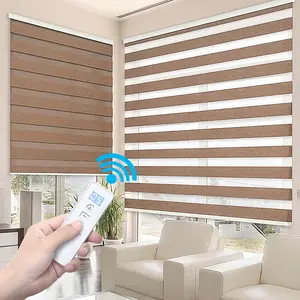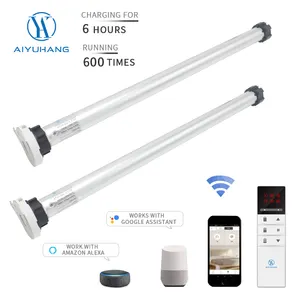
All categories
Featured selections
Trade Assurance
Buyer Central
Help Center
Get the app
Become a supplier

(24900 products available)




















































Roller blind motors are the mechanisms that drive the rolling up and down of the blinds. They replace the manual effort of twisting a rod or pulling a string with an electric or battery-powered option. There are several different types of roller blind motors available on the market, each with its own unique features and benefits. Generally, roller blind motors can be classified into two categories based on their power source, which are electric motor and battery-powered motor. The following will introduce their types separately.
First, the electric motor type is as follows:
Secondly, the battery-powered motor types are as follows:
Roller blind motors come in various designs, each tailored to specific needs, aesthetics, and functionality requirements. The design aspects of these motors encompass structural, mechanical, and electrical features.
Structural design
These motor designs have compact size and light weight as structural features. They are made of strong materials, and their compact structural design ensures they fit seamlessly within the roller blind tube or brackets without being seen. They have a cylindrical or rectangular shape that enables easy mounting within the roller blind system.
Mechanical design
The mechanical design of these motors features a drive shaft that transfers the motor's rotational power to fabric roller blinds to make them roll up or down. They have a gear system that reduces the high speed of the motor into a high torque for the smooth and controlled movement of the blinds. The gear system may also be made as a chain-and-sprocket arrangement for increased efficiency.
Electrical design
The electrical components of a roller blind motor include a power supply, control system, and battery. In some designs, AC motors are used, while others have rechargeable batteries for convenience. The choice of battery or power supply depends on whether the motor will be used wirelessly or need to be connected directly to a power source.
Powering roller blinds with motors enhances their convenience and functionality. These motorized blinds find utility in a variety of settings, each with unique requirements and advantages.
Residential homes
Motorized roller blinds are popular in homes. They offer privacy, control sunlight, and improve home decor. With a remote, users can easily raise or lower the blinds. This is especially helpful for hard-to-reach windows or homes with many floors.
Office buildings
In offices, these blinds reduce glare on computer screens and create a comfortable work environment. They can be programmed to adjust automatically based on the sun's position, which is called smart shading. This maintains a constant level of daylight in the room, which is good for productivity and the looks of the office.
Educational institutions
Schools and universities use motorized blinds in classrooms and lecture halls. They provide quick adjustments for different lighting needs, improving the learning environment.
Healthcare facilities
Hospitals and clinics benefit from motorized blinds. With no touch needed, patients can control natural light and privacy easily. This is good for patient comfort, especially for those who are not well enough to move around much.
Hotels and hospitality industry
In hotels, motorized roller blinds offer guests luxury and convenience. Blinds can be a part of the room's automation system. They can be set to open or close with the touch of a button or automatically at certain times.
Commercial spaces and retail
Retail stores and shopping malls use motorized blinds to control lighting and create dynamic displays. These can be done with the push of a button or automatically to attract customers.
Auditoriums and theaters
Motorized blinds are used to create stages and manage lighting in performances and presentations. They allow for quiet, smooth changes to the setting.
Government and corporate buildings
Motorized blinds are also widely adopted in government buildings and corporate offices. They enhance the aesthetics of the space while providing practical benefits such as privacy and glare control.
Transportation industry
In the transportation sector, motorized blinds are installed in vehicles such as buses, trains, and airplanes. They provide passengers with easy control over natural light and privacy, enhancing the travel experience.
When choosing a motor for roller blinds, factors like motor type, blind size, weight, usage frequency, and control preferences should be considered. One should also consider the fabric and design of the blinds, as well as installation requirements and budget. It is advised to select a motor that is quiet and long-lasting and to ensure compatibility between the blind and the motor.
Determine the blind size and weight.
The size and weight of the blinds should be determined before anything else. Small and lightweight blinds can be powered by many motors, but bigger and heavier blinds need stronger motors with more support.
Consider the motor types.
There are two main types of motors for roller blinds: tube motors that are placed inside the roller blind's tube and external motors that are mounted outside when there is no space inside. Tube motors are more common because they are hidden from view and take up less space.
Identify the power options.
Motorized roller blind motors can either be powered by batteries or electricity. Battery-powered motors offer flexibility in installation, while wired motors provide a constant power supply. Choose according to preference.
Evaluate the control options.
Think about how the roller blinds will be controlled. Motors can be operated using remote controls, wall switches, or smartphone applications through IoT technology known as smart home automation systems where one can control things from their phone or tablet remotely, like Wi-Fi enabled blinds. Decide which method of operation is best for oneself.
Examine the noise level.
Nobody wants a noisy blind. The motor's noise level should be checked, especially if it will be used in quiet places like bedrooms or offices. Choose motors that operate quietly for a peaceful environment.
Check the battery options.
If a battery-powered motor is chosen, the type of battery should be checked to see if it needs replacing often or not. Some batteries can be charged from outside the blind, which is more convenient.
Look at the installation requirements.
It should be determined whether installing the roller blind motor will require professional help or if it can be done by oneself without any extra costs. Some motors may need special tools or knowledge, so one must read the instructions carefully before buying.
Consider the warranty and support.
A warranty for the motor should be obtained in case it breaks down soon after purchase, and good customer support from the manufacturer should be demanded so that questions can be asked about using the product safely.
Compare the costs.
The total cost of the roller blind motor system should be estimated, including all its parts. Cheaper options may save money now but could break more quickly later, so it should be balanced against quality over the long term.
Q1: How can users control roller blind motors?
A1: Roller blind motors can be controlled using remote controls, wall-mounted switches, smartphone apps, or home automation systems. Depending on the model, users can operate the blinds conveniently from a distance or schedule their movement for automatic opening and closing.
Q2: What are the benefits of using motorized roller blinds?
A2: Motorized roller blinds offer convenience, improved privacy, enhanced interior aesthetics, and better control over natural light and glare. They are especially beneficial for hard-to-reach windows and can be integrated into smart home systems for added functionality.
Q3: How do users install roller blind motors?
A3: The installation process for roller blind motors may vary depending on the specific model purchased. Generally, it involves attaching brackets to the wall or window frame, mounting the blind fabric roll onto the brackets, securing the motor, and adjusting the blind position.
Q4: How long do roller blind motors last?
A4: The lifespan of a roller blind motor depends on its quality, usage frequency, and maintenance. Typically, good motors can last for several years. Regular maintenance and avoiding overuse can help extend their lifespan.
Q5: Are roller blind motors compatible with all types of blinds?
A5: Roller blind motors can be used with many window blinds, including roller blinds, roman blinds, and bamboo blinds. However, they may not be compatible with certain designs, such as venetian blinds or custom-made blinds. It is important to check compatibility before purchasing.
The keyword "roller blinds motor" has experienced fluctuating web search volumes over the past year, with an average monthly web search volume of 18,100. Over the last three months, there has been a significant decrease of 45%, and the one-year change shows an 18% decline overall.
Analyzing the monthly data, we observe notable peaks and valleys. For instance, the web search volume dipped to 14,800 in January, June, and July, but surged to 27,100 in August. This pattern indicates seasonal variations, with peaks typically in late summer and valleys in early winter and mid-summer. Such trends suggest that consumers might be more interested in purchasing roller blinds motors during specific seasons, perhaps aligning with home improvement projects that are common during warmer weather.
The reasons behind these trends are multifaceted but could be attributed to consumer behavior patterns, where individuals undertake home renovations during certain times of the year. Additionally, economic factors such as pricing changes or promotions by retailers during peak home improvement seasons could also influence web search volumes. Analyzing these trends helps businesses in the home garden category to better plan their marketing and stock inventory according to predictable demand cycles.